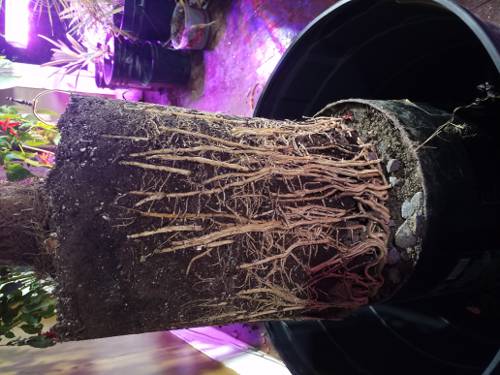
FAQ About Indoor Plant Root System Exploration

What is the importance of understanding indoor plant root systems?
Understanding indoor plant root systems is crucial for ensuring the overall health and vitality of your plants. Root systems are responsible for water and nutrient absorption, anchoring the plant in its growing medium, and storing energy. A healthy root system is fundamental for plant growth, resilience to stress, and overall plant health.

How do root systems vary among different indoor plant species?
Root systems can vary significantly among indoor plant species. Some plants have fibrous root systems, characterized by many thin roots spreading outwards, which are common in grasses and some hanging plants. Others have taproot systems, with a single, thick primary root extending deep into the soil, like in carrots. The type of root system affects how a plant is potted and the kind of soil it requires.

What are common signs of healthy indoor plant roots?
Healthy indoor plant roots generally appear white or light tan and have a firm texture. They should be spreading out evenly in the soil and show no signs of disease or decay. Look for roots that are not coming out of drainage holes excessively, which can indicate that the plant is root-bound and might need repotting.

What are the effects of overwatering on plant root systems?
Overwatering can have detrimental effects on indoor plant root systems. It can lead to root rot, a condition where roots become mushy and brown due to fungal growth triggered by overly damp conditions. This condition restricts the plant's ability to absorb nutrients and oxygen, leading to poor plant health and potentially killing the plant if not addressed promptly.

How can you encourage robust root development in indoor plants?
Encouraging robust root development involves ensuring proper watering practices, using the right soil type, and providing adequate nutrients. It’s important to water plants only when necessary, ensuring that the potting mix has good drainage to prevent waterlogging. Additionally, using a balanced fertilizer can provide essential nutrients that aid in root development.

Why do some plants become root-bound, and how can it be prevented?
Plants become root-bound when their roots grow too large for their container. This typically occurs when a plant has been in the same pot for too long without repotting. To prevent a plant from becoming root-bound, it’s essential to regularly check the root-to-soil ratio and repot the plant into a larger container when necessary. Another way to prevent root-bound conditions is to trim the roots during repotting if they are excessively tangled or dense.

What role do roots play in plant nutrient uptake?
Roots play a critical role in nutrient uptake by absorbing minerals and nutrients from the soil. They use root hairs, which increase the surface area for absorption, to take in essential nutrients like nitrogen, phosphorus, and potassium. This process supports the plant's growth and helps in synthesizing vital organic substances necessary for plant life.

How do different potting soils affect the growth of plant roots?
The type of potting soil used can significantly affect plant root growth. Well-draining soils help prevent root rot by allowing excess water to flow out, while retaining enough moisture for the roots to absorb. Some soils are specifically formulated with added nutrients and are aerated to support root health. It's vital to choose a soil mix that matches the plant's natural habitat requirements for optimal root development.

What are some of the indicators that a plant needs repotting?
Indicators that a plant needs repotting include roots growing through drainage holes, a plant that is top-heavy or wilting frequently, and when the soil surface seems to dry out very quickly after watering. Repotting should generally be considered every year or two, particularly in the growing seasons of spring and summer.

Can indoor plant roots grow in water, and if so, how?
Yes, some indoor plant roots can grow in water through a process called hydroponics or water propagation. In this method, plants are placed in water with necessary nutrients dissolved in it. The roots absorb these nutrients directly from the water, and this can be an efficient way to develop a strong root system. Plants like pothos and philodendrons are popular for growing in water.

How do air roots function differently from soil roots?
Air roots, or aerial roots, are adapted to absorb moisture and nutrients directly from the air, unlike soil roots, which absorb from the soil. These types of roots can be seen in plants such as epiphytes, like orchids and some ferns, which grow on trees or in the air. Air roots help stabilize the plant and can also aid in photosynthesis in some cases.

Are there specific nutrients that benefit root growth?
Yes, certain nutrients are especially beneficial for root growth, primarily phosphorus, which is crucial for the development and expansion of the root system. Fertilizers with a higher phosphorus content, indicated by the middle number in the N-P-K ratio, are often used to promote healthy root growth. Other micronutrients like calcium might also support root tip growth and overall root structure.

How does soil compaction affect root health?
Soil compaction can significantly affect root health by creating a dense environment that restricts root growth and impedes water and oxygen flow. This can lead to a lack of oxygenation and water retention, resulting in poor nutrient absorption and overall reduced plant health. Aerating the soil and ensuring it is not too compacted can help maintain a healthy root system.

What are root rot and how can it be identified?
Root rot is a disease that affects plant roots, often caused by overwatering or poorly draining soil, leading to fungal infection. It is characterized by soft, brown, or blackened roots that may emit a foul odor. To identify root rot, inspect the roots by gently removing the plant from its pot and looking for these signs. If detected early, treatment involves removing affected roots and improving soil drainage.

How do indoor plant roots contribute to overall plant health?
Indoor plant roots contribute to overall plant health by ensuring the efficient uptake of water and nutrients, storing energy, and anchoring the plant securely in its growing medium. Healthy root systems support the plant's growth, assist in coping with stress such as drought or disease, and are crucial for long-term plant vitality.

What are the differences between taproots and fibrous roots in indoor plants?
Taproots and fibrous roots differ primarily in their structure and function. Taproots consist of a single, large primary root with smaller lateral branches, commonly found in plants that require deep anchorage and stability. In contrast, fibrous roots are made up of numerous small, branching roots that spread out closer to the surface, allowing efficient absorption of nutrients and moisture from the topsoil. Each root type impacts the potting needs and care of indoor plants.

Can root pruning benefit indoor plants, and if so, how?
Root pruning can benefit indoor plants by stimulating new root growth, preventing root bound conditions, and encouraging a more robust root system. When done correctly, trimming back some of the roots during the repotting process can help the plant absorb nutrients more efficiently and direct energy towards healthier, more balanced growth. Care should be taken to avoid over-pruning, which may harm the plant.

What are some common misconceptions about indoor plant roots?
A common misconception about indoor plant roots is that they don't need any special care aside from watering. In reality, roots require appropriate soil, nutrients, and space to grow healthily. Another misconception is that visible roots above the soil indicate poor health; some plants naturally have aerial roots, which are normal and part of their growth habit.

How does the size of the pot affect root development in indoor plants?
The size of the pot can greatly affect root development. A pot that is too small can restrict root growth and lead to a plant becoming root-bound, where roots wrap around within the limited space. Conversely, a pot that is too large can lead to water retention issues and root rot, as the soil may stay moist for too long without the roots effectively absorbing water. Choosing the right size pot ensures optimal root growth and overall plant health.

Are there specific indoor plants known for their extensive root systems?
Yes, some indoor plants are known for their extensive root systems. For example, the rubber tree (Ficus elastica) and the fiddle leaf fig (Ficus lyrata) have complex root systems that require ample space and frequent repotting. These plants benefit from large containers to accommodate their root growth and sustain their size and health.
